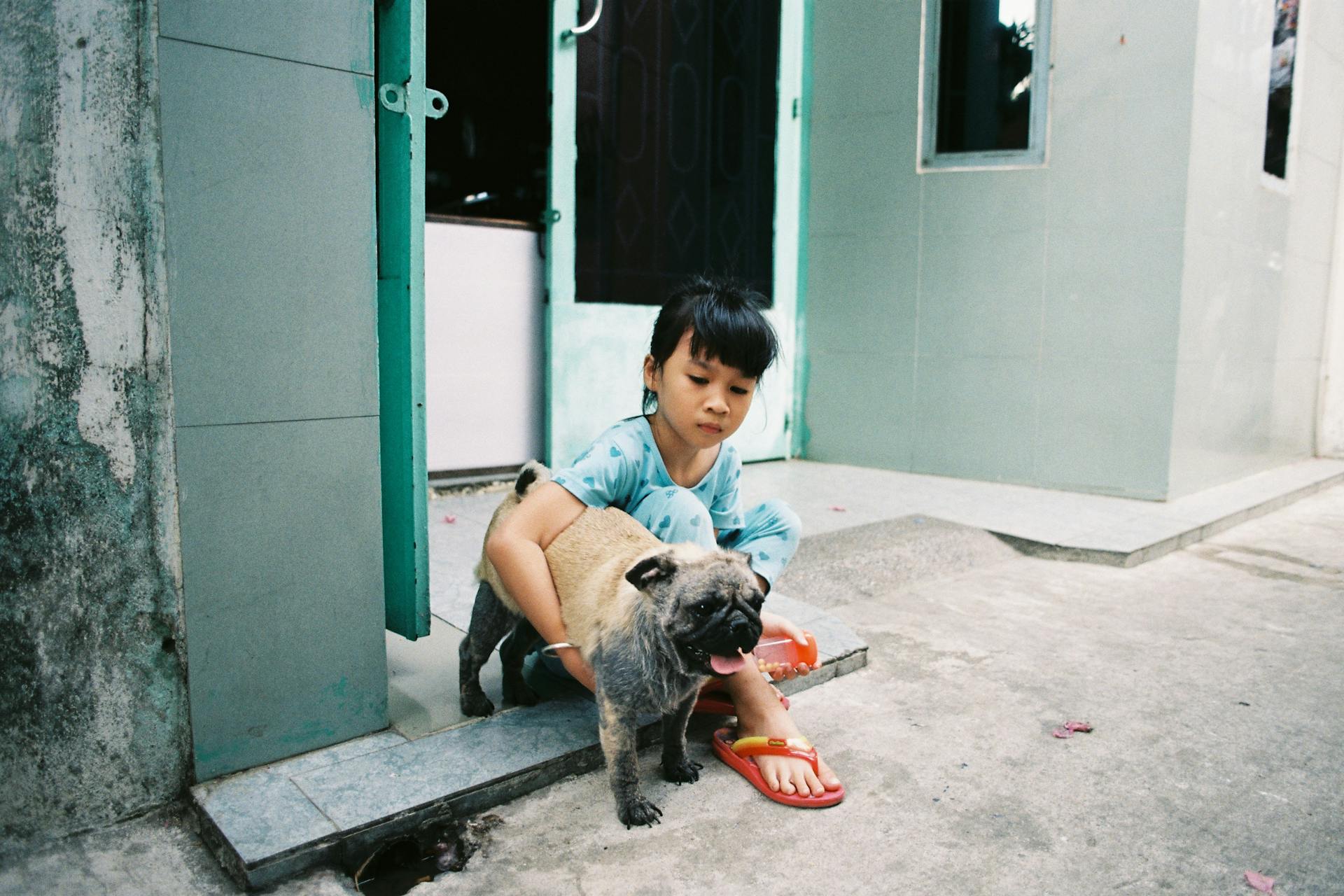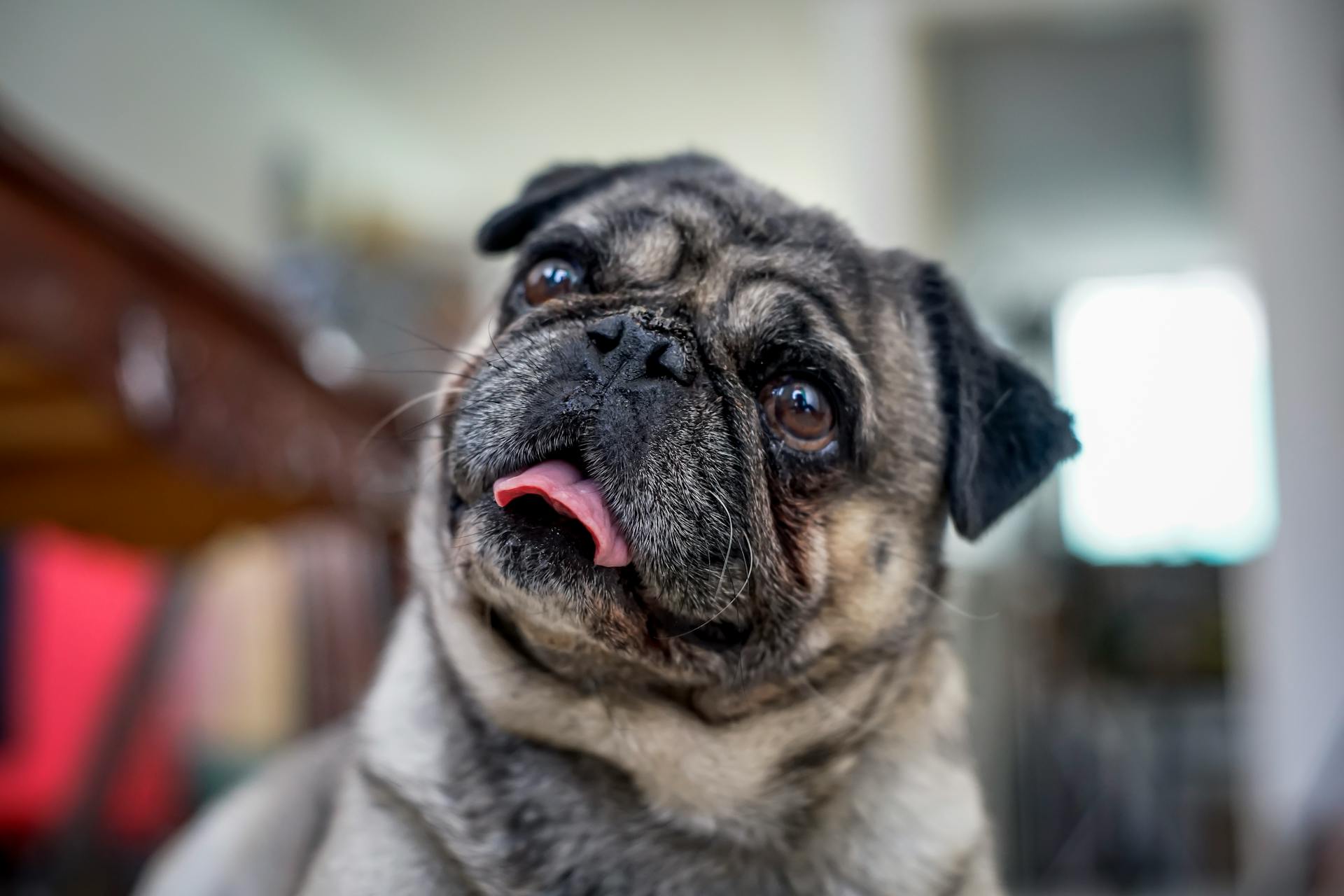
Pug dog eyes are prone to popping out due to their unique facial structure. The bulging eyes can be a result of their short, flat face and shallow eye sockets.
A pug's eyes are more susceptible to popping out because of their brachycephalic skull shape, which can cause their eyes to bulge forward. This increases the risk of eye injuries and vision problems.
To prevent pug dog eyes from popping out, it's essential to keep their face clean and dry. Regularly wiping their eyes with a damp cloth can help prevent dirt and debris from entering their eyes.
Pugs are also more likely to experience eye problems due to their shallow eye sockets and prominent eyes.
Worth a look: How to Prevent Diabetes in Dogs
Causes and Symptoms
Pugs are prone to a condition where their eyes pop out of their sockets, and it's crucial to understand the causes and symptoms to provide the best care for your furry friend.
Trauma to the eye or face is a common cause of proptosis in pugs, which can happen during rough play or accidents. This can lead to a range of symptoms, including irritation, rubbing, and bulging of the eye.
Pugs are also more susceptible to proptosis due to their brachycephalic skull structure, which can create space-related issues within their skull. This means that even pressure on the neck from a collar can cause ocular proptosis.
Here are some common signs and symptoms to look out for:
- Bulging eyes: The most apparent sign is bulging or protruding eyes.
- Redness and inflammation: Proptosis often causes redness and inflammation around the affected eye.
- Discharge from the eyes: You might observe discharge or excessive tearing from the affected eye.
- Pain and discomfort: Proptosis can be painful for pugs, so look for signs of discomfort like pawing at the eye or whimpering.
If you notice any of these symptoms, it's essential to seek immediate veterinary care to prevent further complications.
Signs and Symptoms
If you notice that your dog's eyes seem to be bulging out of their sockets, it's a clear indication of proptosis. This can be a sign of trauma to the eye or face.
Trauma to the eye or face can cause the eye to bulge out of its socket, and in severe cases, it can even be completely out of its socket and hanging out.
More subtle symptoms that may begin prior to the obvious symptoms include irritation of the eye and rubbing of the eye.
Check this out: Dog Face Pug

Here are some other signs to look out for:
- Uneven eyes (affected eye is protruding)
- Strabismus (cross-eye)
- Corneal desiccation (dry eye) when at least 1 hour has elapsed
- Conjunctivitis, reddish blood vessels in eye
If you're unsure if the eye is indeed bulging, try viewing it from the side or from the top of their head. This may make the difference in the size of the two eyes more apparent.
Redness and inflammation around the affected eye are common symptoms of proptosis. This can be accompanied by discharge or excessive tearing from the affected eye.
Proptosis can be painful for dogs, so if your dog displays signs of discomfort, such as pawing at the eye or whimpering, seek immediate veterinary care.
What Causes a Dog's
A dog's eye can fall out due to various reasons, including trauma, fighting, and head injuries. In some cases, even excessive scratching can cause the eyes to become irritated and pop out.
Trauma is a common cause of proptosis, especially in brachycephalic breeds like pugs and bulldogs. Their facial structure has shallow eye sockets, making them more vulnerable to injuries.
Curious to learn more? Check out: Dog Eye Diseases That Cause Blindness
Physical injuries or trauma to the head can result in proptosis, which can happen during rough play, collisions, or accidents. Pug owners should be cautious and supervise their pets during playtime.
Genetic predisposition can also play a role in eye issues, including proptosis. Regular check-ups with a veterinarian can help identify such risks early on.
Here are some possible causes of proptosis in dogs:
- Trauma to the eye or face
- Fighting or head injuries
- Excessive scratching due to irritation
- Genetic predisposition
It's essential to recognize the symptoms of proptosis, which can include uneven eyes, strabismus, corneal desiccation, conjunctivitis, and redness and inflammation around the affected eye.
Diagnosis and Treatment
Diagnosis of Prolapsed Eye in Dogs is a pretty straightforward process. Veterinarians can diagnose a prolapsed eye with one quick look at your dog.
The eye may appear to be bulging out of the socket, and it's a very obvious condition. Even a non-medical related person will know something is not right.
If you suspect that your pug is experiencing proptosis, it’s crucial to act swiftly and seek professional veterinary assistance. Timely treatment can often save your pug’s vision.
Proptosis is diagnosed based on a traumatic history, an acute onset, and a characteristic clinical appearance. This includes rostral protrusion of the globe, clinician’s inability to see the eyelid margins, and patient’s inability to blink the eyelids over the cornea.
Other potential signs include pain, periocular swelling, hemorrhage, and strabismus. Proptosis is easily differentiated from exophthalmos and buphthalmos, which also cause a “bulging eye” appearance.
If you are able to pop the eye back into its socket relatively soon after it prolapsed, the prognosis for it staying in place is good. However, if it is out of the socket for too long, the prognosis declines.
Prolapse Recovery and Care
If you're able to pop the eye back into its socket relatively soon after it prolapses, the prognosis for it staying in place is good.
The sooner you act, the better chance your dog has of keeping its eye in place. However, if it's out of the socket for too long, the prognosis declines.
Even if the eye is put back into place, the chance of vision returning to the eye is only 50%.
Dogs can adapt quickly to losing an eye and only have one remaining eye to work with. They can live a normal life without the second eye.
Some owners may decide to have the globe removed completely and replaced with a glass globe to maintain the eye's form. This is a viable option for dogs with one eye removed.
For your interest: One Blue Eye One Brown Eye Dog Names
Veterinary Advice and Concerns
If your Pug's eye pops out, don't try to shove it back into its socket, as this can cause more damage. Let a skilled and trained vet do the work.
You should keep the area clean and free from dirt, and wash your hands first before trying to clean the area. Use a sterile eye wash, not water or any other liquid.
A sterile gauze should be used to cover the area, and a protective collar around your dog's head can prevent them from scratching it further and causing more damage.
Consider reading: How to Clean Maltese Dogs Eyes
Here are some key steps to follow:
- Do not try to shove the eye back into its socket.
- Do not disinfect the area, but instead use a sterile eye wash.
- Use a sterile gauze to cover the area.
- Put a protective collar around your dog's head to prevent further damage.
Time is of the essence, so take your Pug to the nearest emergency vet care as quickly as possible.
Prolapse: Veterinary Advice
If your dog's eye has popped out of its socket, it's essential to act quickly and carefully. Do not try to shove the eye back into its socket, as this can cause further damage.
A protective collar around your dog's head can help prevent them from scratching the area further. This will also reduce the risk of infection.
Keep the area clean and free from dirt by using a sterile eye wash, not water or any other liquid. Wash your hands first before trying to clean the area.
Cover the area with a sterile gauze to protect it from further damage. This will also help keep the area clean and free from dirt.
If your dog's injury is severe, surgery may be required. In this case, it's crucial to get your dog to an emergency vet as quickly as possible.
Intriguing read: Dog Illness Bay Area

Here are the steps to take if your dog's eye has popped out of its socket:
- Put a protective collar around your dog's head to prevent scratching.
- Use a sterile eye wash to clean the area.
- Cover the area with a sterile gauze.
- Take your dog to the nearest emergency vet as quickly as possible.
Remember, time is of the essence, and getting your dog to a vet quickly can make all the difference in their recovery.
Pug Blindness Concerns
Pug Blindness Concerns can be a real worry, especially if your Pug's eye pops out. The severity of the injury and how quickly you get your Pug help will determine the outcome.
If your Pug's eye is injured, the sight of the eye will depend on the severity of the damage to the eyeball, the eye socket, or the tissue surrounding the eye. The key is to keep the eye moist without letting any dirt in.
You can help save your dog's sight by putting some saline solution on a sterile gauze bandage and then quickly covering the eye and the socket. This will help keep the eye moist.
Don't remove the gauze until the vet does it in their office or exam room.
Frequently Asked Questions
Is it common for Pugs to lose their eyes?
While it's not common for Pugs to completely lose their eyes, they are prone to severe eye issues like corneal ulcers and pigmentary keratitis due to their unique anatomy. This can lead to vision loss or blindness if left untreated.
Why does my pug have weird eyes?
Pugs are prone to bulging eyeballs due to their shallow eye sockets and pushed-in facial structure. This unique combination can also cause their eyeballs to appear unusually large.
Sources
- https://wagwalking.com/condition/prolapse-of-the-eye
- https://docferdsanimalwellness.com/2021/08/13/pet-owners-guide-101-ocular-proptosis-in-dogs/
- https://pugspedia.com/why-do-pugs-eyes-pop-out/
- https://patchpuppy.com/dog-breeds/do-pug-eyes-fall-out/
- https://todaysveterinarypractice.com/ophthalmology/ocular-proptosis/
Featured Images: pexels.com


